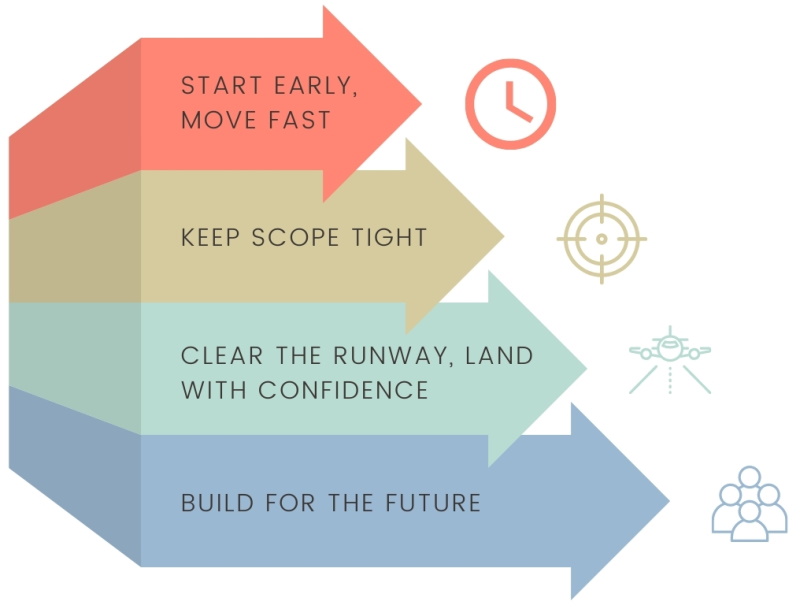Speed up your projects with these simple rules. Accelerate change and deliver real value to your customers.
During the pandemic, retailers became increasingly reliant on technology. According to Experian Economics, online retail sales rose from 12% to 34% of total retail spend in the past year [1].
Technology is now a key differentiator, separating the haves from the have-nots. The successful from the struggling.
Fortunately, most companies see this, and they want to do something about it. Retailers are already ramping up project activity and investment. For some it’s a last throw of the dice. For others it’s a chance to surge further ahead.
While change is undoubtedly the way forward, anyone implementing new solutions must be cautious. In their CHAOS 2020 report, The Standish Group reports that only 35% were successfully completed on time and budget [2].
Thankfully, Spike has helped many retailers successfully deliver change projects. The most successful of which share 4 key principles.
Spike’s 4 Golden Rules
As you know, software is more complex than ever. Integrated systems, multiple front ends and peak trading pressures are just a few of the technical challenges you face. Implementing a new solution can be daunting. But it doesn’t need to be.
Change projects are a journey. No two journeys are ever quite the same, and neither are projects. There will be detours and roadworks along the way. But they’re all manageable, with the right approach. Our 4 golden rules will help you reach your goal as quickly as possible.
Retailers face different pressures than other sectors. For one thing, there’s acute seasonality and fixed timeframes; other sectors can slip their projects by weeks or months without much impact, most retailers can’t.
Your projects need to move quickly from concept to reality. You can’t afford to lose time.
We also have unique supply chain pressures and cost sensitivity. More now than ever. Your projects need to ease these pressures, not increase them.
You need to get quickly get past the technology and start realising results. You’re only going to do this if you start early and push all the way through into project completion.
We’ve seen many projects start off with a bang but run out of momentum as things progress. Often barely limping over the line. Almost always, this is due to poor preparation.
To prevent delays, you must make sure all involved parties are ready:
- Operations staff know what’s coming
- You’ve got tools and environments in place
- Your training team is onboard
- Every team must know their roles, responsibilities, and timelines
- To maintain project momentum, you need to line everything up ahead of time.
2. Keep Your Scope Tight
Scope creep is the bane of software projects. Nothing will scupper your chances of success quite like it.
You start off building a simple ecommerce site. Within a few weeks you’re building an omnichannel solution. Nobody’s quite sure how you got there.
For a project to succeed it needs to be realistic and contained. Build a solid base. Get the fundamentals right first and add to it later.
Keep your scope focussed on the minimum viable product. Don’t give into the temptation to add more. Be firm, even when the board start asking. Remind them of the Pareto principle.
Build 20% of your dream solution, get 80% of the real-world benefits.
First and foremost, you need to develop a high-quality solution. One that:
- Meet your business goals
- Functions as expected
- Performs correctly under all load conditions
- Provides an excellent experience
BCG research states “70% of digital transformations fall short of their objectives, often with profound consequences” [3].
High quality software is only possible with efficient and effective software testing. This is where we directly help retailers.
Spike prevent the anguish associated with digital change. Our quality-first culture helps you enjoy a painless end-to-end transformation.
Once you have a quality solution ready you need to develop a clear cutover plan. By that we mean, how will you integrate your new system into the business. This must go right. With the right prep and teamwork, it will.
Build and refine your cutover schedule. Plan in rehearsals, and practice, practice, practice.
Other projects may well be landing at the same time. Ideally you want to cutover with as few moving parts as possible, but it’s not the end of the world. Make sure you know what else is happening in the business.
4. Build for the Future
Always remember, the initial project is just the start of your journey. You will run your system for 3 or 4 years, or even longer. When you get this phase right, the next few years will be so much easier. This project is your chance to drive further change and accelerate future projects.
Often, solutions land and the business doesn’t understand their full potential. Projects can become too insular, focussed on deadlines and deliverables.
Take the whole company on your journey.
Communicate regularly to other areas of the business. Let them know what’s coming. Present the key features. Explain to them just what this new system is capable of.
Accelerate Change and Deliver Value to Your Customers
Change is always challenging, but by focusing on what matters you can accelerate your digital transformation journey. With Spike’s 4 golden rules, you can reduce time and complexity, and deliver real value to your customers.
Spike. Perfecting retail technology. Visit http://www.wearespike.co.uk/for more information.
1. https://www.independent.co.uk/business/pandemic-has-turbocharged-digital-transformation-report-finds-b1886296.html
2. https://www.standishgroup.com/news/49
3. https://www.bcg.com/publications/2020/increasing-odds-of-success-in-digital-transformation
To find out more about Spike and the services they provide to the retail industry, click here.
This article was also published in The Retailer, our quarterly online magazine providing thought-leading insights from BRC experts and Associate Members.

